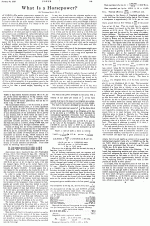The bizarre thing is that the US refused the metric system for being 'too french' and so retained the medieval french Avoirdupois system to this day.
Cute. However the people in the US who actually had to measure stuff urged adoption of Metrics all through the 1800s.
One small reason is that the Imperial Yards that GB US and Can were using were shown with improved comparison to be not-stable, and the French had newer-tech sticks which held length better. The IY was good enough to sell cloth, but uncertainty was not a lot better than 1%. Which is why when the Imperial countries adopted the Meter they didn't use some long-digit conversion, the Inch was decreed to be 25.4mm exact.
Not that the Kilo is stable. But is it gaining or losing??
Reference kilo shows mysterious weight loss • The Register
Fatty French Kilogram needs a new-year diet, say Brit boffins • The Register
However the Inch was good enough for my forefathers and it is good enough for me. WWJD? Joseph The Carpenter used the width of his thumb to pick boards and mark notches.
Actually _I_ learned my inches on a Meter Stick. There was a slight fad for everyday metrification in the 1950s. The only thing to come out of it were some advertising 'yardsticks' 39+" long with the phrase "we go the extra length" on one side and cm marks on the back. So I knew about what a cm was, though I didn't internalize it until later with camera lenses. US lenses marked in Inches, German in mm. 4 of one is 100 of the other.
English pubs and their "rudderless and bewildered majority" clients cling to their Pints.
Pints under attack as Lord Howe demands metric-only UK • The Register
UK gardeners measure plots in 600 year old Poles (what we call Rods or Perch), even if their landlords bill it in square meters. Middle England's allotments become metric battlefield • The Register
England used "stones" for a long time. There were 6 or 8 different stones for different trades. Some differences were meaningful: a whole cow was one kind of stone, the carcass was another, and the difference approximated the usual yield of the butchering. All these fell into disuse but a New stone of 14 pounds (6.35029318 kg) became the customary way to say your body weight. The Scots had bigger stones until 1824.
No matter. The Register has promulgated new and rational units of measurement.
So, what's the velocity of a sheep in a vacuum? • The Register
Yes, US drinks are marked both ways, and there may be a rule behind that, but the key reason is that drinks are sold globally, also their bottle making machines, and I hear there are many places where Quarts are strange and Liters are familiar.
Have you attended a Scottish Highland Games lately?The Scots had bigger stones until 1824.
P.S. "I'm just going out for a pint dear." will never be replaced in the UK by "I'm just going out for a 568ml dear."!
Correct me if I'm wrong, but I believe a liquid pint in the US is only 473ml. Being short changed to that extent would not be be tolerated in a Scottish pub!
(Both measures rounded to the nearest ml of course.)
Correct me if I'm wrong, but I believe a liquid pint in the US is only 473ml. Being short changed to that extent would not be be tolerated in a Scottish pub!
(Both measures rounded to the nearest ml of course.)
When I was an apprentice machinist at a national lab in the 1980s, the US government was on a metric kick. All the machine tools had increments in inches and mm. First thing we did when we got a metic dimensioned drawing was to convert from mm to inches, since the measuring tools read in inches. BTW- the kilogram was the only unit of measurement used for mass calibration. Now, anyone can build their own Kibble Balance and won't have to rely on the SI kilogram standard.
I've been knocking my pan out trying to build one!Now, anyone can build their own Kibble Balance.
Attachments
I think the US pound is defined in kg,...
I think it was so in 1913, certainly Yard was already defined in terms of Meter; yet the readers of POWER magazine raised a hoo-ha-hah about the value of a Horsepower in light of new geo-surveys showing different gravity at different places.
The actual functional definition of a Horsepower _IS_ lifting against gravity, and specifically pumping water up out of a mine (what Watt was selling). So if gravity is less, you need a smaller horse for the same water and lift. But it gets complicated. Boiler Pressure is defined in Pounds and was sometimes regulated by an iron weight. Lower gravity, lower pressure, lower power.... somewhat self-compensating. Ah, but Watt was selling Vacuum engines, not using steam pressure to lift water. OTOH these "atmospheric" engines depended on local air pressure which varies more than gravity. But by 1913 it was all steam *pressure* engines, often 10 Atmospheres and sometimes condensing to vacuum.
This letter has many objectionable passages and the debate went on for months. One I note is that he thinks "39.37" is an approximation, but in 1913 it was exact by fiat.
I just checked my 1995 Glover's Pocket Ref. Says a mechanical Horsepower is 745.7 Watts. The actual work done must have changed in the 5th place as Ohm and Ampere standards evolved. Watt would be amused-- he picked 33,000 foot-pounds(force)-minute "high" so he could be sure his "One Horsepower" engine would beat any typical horse used to pump mines, no customer quibble.
Attachments
P.S. "I'm just going out for a pint dear." will never be replaced in the UK by "I'm just going out for a 568ml dear."!
Correct me if I'm wrong, but I believe a liquid pint in the US is only 473ml. Being short changed to that extent would not be be tolerated in a Scottish pub!
(Both measures rounded to the nearest ml of course.)
That's because pints are derived from gallons and the Imperial Gallon equals about 4.5L while the US Gallon is about 3.8L.
The bizarre thing is that the US refused the metric system for being 'too french' and so retained the medieval french Avoirdupois system to this day.
No this is not true, The USA rejected the metric system because it was too difficult for older Americans to adopt to a new system. We were to have switched by 1979(enacted in 1976?) and had dual speedometers and dual markings on highway signs. Due to protest by older citizens and their lobbies, the rule was reascended under Carter and we are stuck being the odd man out.
Sad thing is we are actually metric in all manufacturing and sales, but "English" officially.
It had nothing to do with Francofibia.
...pints are derived from gallons...
England had several things called "gallon" depending what was being sold.
IIRC the Colonies tended to use the "wine gallon", and the UK unit of petrol was based on another size of gallon, maybe Corn? (Americans: in England "corn" means grain, not ears of Indian Corn.)
I may be mixed-up. Gallon - Wikipedia
Anyway, we all fail Physics class. A gram is not a measure of weight, it's mass.
And a cubit is not a cubit, depends on who you are. So any weight measurement based on volume calculations from a specific cubit would have wildly varying mass, pending on material properties and the actual cubit involved.
... I guess it's mass failing just discussing it, but what if we span up the heavy bigger circumference turntable and measured then?
Last edited:
The meaning may not be the same in the other three constituent countries of the UK.Americans: in England "corn" means grain, not ears of Indian Corn.
In parts of Scotland, for example, 'corn' refers to oats and to no other grain.
A Scotsman likes to get his oats, preferably first thing in the morning!
Attachments
"Corn" generally meant "the local stuff used for daily bread", what the people live on, which can include porage and heavy beer. Mostly cereals (not Kellogs); sometimes beans. Oats, rye, barley, wheat, etc, depending on climate and soil. In America, "indian corn", maize, grew wild and was easy to cultivate in "hills" (without plows). It was certainly the "corn", the "daily bread", of the early settlers. So much that when wheat cultivation exploded, we called it "wheat", ignoring English tradition. (Now we put much of our vast indian-corn production into cows and cars.)
Member
Joined 2009
Paid Member
Comprehensive information PRR.. . .when wheat cultivation exploded. . .
You certainly don't hide your light under a bushel!
"The old bushel was a unit of mass equal to 2 kennings, 4 pecks or 8 dry gallons and was used mostly for agricultural products such as wheat."
Now, that is taking humour to the Max!The new "Constant Planck" has been seen recently.
Member
Joined 2009
Paid Member
The meaning may not be the same in the other three constituent countries of the UK.
In parts of Scotland, for example, 'corn' refers to oats and to no other grain.
A Scotsman likes to get his oats, preferably first thing in the morning!
Is that Wee Geordie on the label, it was a wonderful film I saw as a kid?
- Status
- This old topic is closed. If you want to reopen this topic, contact a moderator using the "Report Post" button.
- Home
- Member Areas
- The Lounge
- New Kilogram definition




